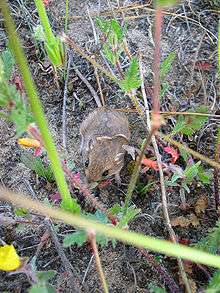Little pocket mouse
The little pocket mouse (Perognathus longimembris) is a species of rodent in the family Heteromyidae. It is found in Baja California and Sonora in Mexico and in Arizona, California, Idaho, Nevada, Oregon and Utah in the United States.[1] Its natural habitat is subtropical or tropical dry lowland grassland. It is a common species and faces no particular threats and the IUCN has listed it as being of "least concern".
| Little pocket mouse | |
|---|---|
 | |
| Scientific classification | |
| Kingdom: | Animalia |
| Phylum: | Chordata |
| Class: | Mammalia |
| Order: | Rodentia |
| Family: | Heteromyidae |
| Genus: | Perognathus |
| Species: | P. longimembris |
| Binomial name | |
| Perognathus longimembris (Coues, 1875) | |
Five mice of this species travelled to and orbited the Moon 75 times in an experiment on board the Apollo 17 command module in December 1972. Four of the mice survived the trip.[2] Six other little pocket mice were sent into orbit with Skylab 3 in July 1973, though these animals died only 30 hours into the mission due to a power failure.[3][4]
Behavior
The small mouse with a long tail inhabits arid and semiarid habitats with grasses, sagebrush and other scrubby vegetation. It is nocturnal and has a shortof activity for the first two hours after sunset and then sporadic activity through the rest of the night. It sleeps in winter and is only active between April and November with numbers building up rapidly in the spring to peak in June and July. It forages for seeds, plant material and small invertebrates which it carries back to its burrow in its cheek pouches.[5]
Status
The little pocket mouse is common within most of its range although it is scarce in Baja California. The population appears to be steady and no particular threats have been identified for this species so the International Union for Conservation of Nature has assessed it as being of "least concern".[1]
See also
- Pacific pocket mouse (Perognathus longimembris pacificus) — an endangered subspecies from coastal Southern California.
References
- Linzey, A.V. (2008). "Perognathus longimembris". IUCN Red List of Threatened Species. 2008. Retrieved 22 January 2009.CS1 maint: ref=harv (link) Database entry includes a brief justification of why this species is of least concern
- Haymaker, W., Look, B., Benton, E. & Simmonds, R. Biomedical Results of Apollo. Chapter 4: The Apollo 17 Pocket Mouse Experiment. NASA SP-368, 1975.
- Souza, Kenneth, Robert Hogan, and Rodney Ballard, eds. Life into Space: Space Life Sciences Experiments. NASA Ames Research Center 1965—1990 Archived 2009-03-21 at the Wayback Machine. Washington D.C.: National Aeronautics and Space Administration, 1995. NASA Reference Publication-1372 (online version).
- Borkowski, G., Wilfinger, W. & Lane P. "Laboratory Animals in Space Archived 2007-12-06 at the Wayback Machine," Animal Welfare Information Center Newsletter, Vol. 6 No. 2-4, Winter 1995/1996.
- O'Farell, Michael J. (1974). "Seasonal Activity Patterns of Rodents in a Sagebrush Community". Journal of Mammalogy. 55 (4): 809–823. doi:10.2307/1379409. JSTOR 1379409.
